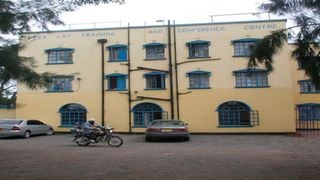
The original Zambezi Motel, now owned by the PCEA church. Once a beer den, it is now a training institute for lergymen.
| PoolKiambu
Premium
Story of Zambezi, Kikuyu town that hosts a centre for clergy that was once a beer den
Last week, several amused readers wrote back after I mentioned that the origin of the name Juja was connected to two sculptures, nay idols, which were brought from West Africa by the American steel millionaire, Northrup McMillan. This reminded me of another story – and which is also forgotten – on why a Kenya town, along the Nairobi-Nakuru highway, in Kikuyu, is named Zambezi.
As students of history are reminded, names carry with them meanings and there is usually a story behind most of them. And that is why it is easier to trace the history of a place by simply understanding the names.
Now, welcome to Zambezi, the only existing legacy of, Siegfried Aron, and his wife Josephina Aron, who later changed her name to Josefina Selamis Larons.
Njogu-Inn
At the end of colonial rule in 1963, there existed a motel along the Nakuru highway known as Njogu-Inn, which was popular with settler revellers as a stop-over. But then, as more settlers started to leave, Njogu-Inn started losing its clientele and was auctioned – or put on sale by the previous owners, the family of John Berkley-Mathews, which is another story.
Before he was waylaid on August 18, 1954, inside Sigona Golf Club by the Mau Mau and shot dead, Berkley-Mathews had become the first owner of a golf course in Kenya after he invested his money in the 18-hole Sigona Golf course in 1938. He had hired the services of an eccentric designer, Tom Simpson. Besides Sigona, Berkley-Mathews, a Cambridge University trained lawyer, had wished to build an industrial complex in Kikuyu through his company Kikuyu Estates Limited.
Actually, he was not the founder of that company but had followed his father, Frederick, who had made a fortune in the area after he helped introduce wattle trees from Australia and built a factory in Kikuyu. His company, British East Africa Wattle Estates and Extract Co. Ltd, which was what later became Berkley-Mathew’s Kikuyu Estate Limited, had pioneered the wattle bark trade used in the production of leather. It also got some tender to supply fuel wood to the Uganda Railways.
Beer den
The tannin factory was built adjacent to Sigona Golf Club and nearby, John had built the Njogu-Inn, which was more of a beer den from 1947 with some of the buildings constructed in 1953, a few months before he was shot dead. And that is why some of the buildings in Njogu-Inn have underground bunkers.
The death of John Berkley-Mathews threw the investment into ruin and his wife, Elisabeth Harcourt (she died in 2001) decided to sell the entire estate. At first, she advertised the sale of Njogu-Inn for £32,000, which was for the entire building and its contents. Interestingly, there were no takers as more properties were thrown into the market. By June 1963, she had sold the chattels and brought the price to £6,000 and still there were no takers.
“My company is taking its interests out of Africa. We are sorry of course, but it is one of those things. We have already got rid of everything else,” she told a journalist, perhaps frustrated that Njogu-Inn was not attracting buyers.
But the name had been adopted in early 1963 by a Kangema-born businessman Mwangi Gakere, who had opened a bar in Nairobi and named it Njogu-Ini Bar. Whether this was a coincidence has never been known but Njogu-ini (for that is how locals around Sigona used to call it) cleverly took the brand name – complete with the elephant logo.
She had then managed to sell his Kikuyu Estate to Prime Minister Jomo Kenyatta’s Finance and Economic Planning minister James Gichuru for she knew that he would allow her to repatriate the money with no questions. Gichuru, interestingly, was not interested in the motel business – even though he loved his beer.
And that is the time that Siegfried Aron, and his wife Josephina Aron, appeared and offered to buy the Njogu-Inn, which was now overgrown with grass and the denizens of the wild had found a new habitat.
“It is the best gesture of our faith in this lovely country,” Josephina told the press.

Ms Josephina Aron, the original owner of the Zambezi Motel, with the two genets named ‘Zam’ and ‘Bezi.’
Young cats
It was while pulling down one of the buildings in the compound that Josephina stumbled on two genets, a spotted cat-like carnivore, which were thought to be sacred in ancient Egypt. Rather than kill them, Josephina decided to keep the young genets and domesticate them. She named one ‘Zam’ and the other ‘Bezi’ for they were the first residents of what was former Njogu-Inn. Thus, she named the new establishment Zambezi Motel.
It is a story that Josephina has previously told for people thought that Zambezi was picked from Zambezi River.
“We found the animals when about five days old while we were pulling down a house in the motel’s ground. They are supposed to be very difficult to tame but I am having a try.”
But still, Josephine’s husband, a real estate agent, had previously worked in both Rhodesia and Zambia, and was known to have fallen in love with the Zambezi River. Whether he immortalised that with the cats or with the 65-bedroom business is an open question. But according to Josephina, it was more about the two cats.
Designed to be a stop-over for motorists, Zambezi was lavishly furnished, and had a site for caravans when it opened its doors on November 30, 1963 as the new Zambezi Motel – some two weeks before independence. A single room would cost Sh25 while a double Sh45 by 1963. And by 1969, this had climbed to Sh45 for single and Sh80 for a double. More so, Zambezi was the lover’s paradise and emerging politicians and civil servants knew about it.
While Njogu-Inn had been completed in 1953 just as the Mau Mau war broke, it was a bad investment while looking back. Possibly, a bad bet for an investor who failed to read the mood of the nation. While the owners had started constructing in 1947 – the year that Jomo Kenyatta took over leadership of Kenya African Union (KAU) and started agitating for change, there were those who thought that the ‘white man’s country’ was forever. And that explains why the building has bunkers to safeguard the clients – just in case of political trouble.
No profits
I recently came across an old review of Zambezi and Josephina was grumbling that because her motel was far from the city, it was putting people off. At one point, she was forced to drop the cost of a double room from Sh80 to Sh35. But Zambezi – despite the kind of publicity it got – did not make profits. For years, the sign Zambezi was much more prominent than its popularity.
As the dollar crisis began in 1970s, following the oil crisis that threw the tourism industry into a spin, the Kenyan economy started to wither. By 1978, there was no chance that the Zambezi Motel would survive.
The Presbyterian Church of East Africa was now looking for facilities around Kikuyu to build a training centre for its laymen. Zambezi, though it was a motel, was the best such place. It had also become a place for seminars given its accommodation facilities. The PCEA had asked the law firm of Waruhiu and Muite to help negotiate the deal, which was concluded on February 6, 1978.
Centre of theology
As a result, a new PCEA Pastoral Institute, today a centre of theology in that church, opened in what was previously a centre of vice. Some of the early trainers here included Dr Rev Timothy Njoya.
And that, neither Juja nor Zambezi sit alone in that space. There could be many other places with names which are the result of such backgrounds.
Whether the name Zambezi was derived from the two genet cats or was directly named from the Zambezi River is an indicator of how entertainment place investors leave landmark names where they operate.
Of course we don’t know what became of Zam and Bezi and whether the proprietor managed to tame them. But the bigger story is how businesses leave an imprint in their locations long after they have closed shop. Of late we have such establishments as Kikopey and Kamaki’s which have followed this tradition.
And that is the short story of Zambezi, the beer place that is today training ground for clergymen. What a twist of fate.
[email protected] @johnkamau1





